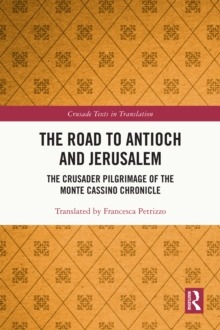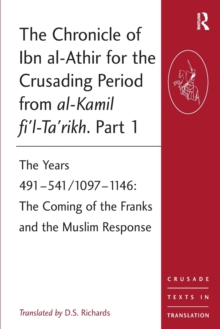
The Chanson des Chetifs and Chanson de Jerusalem : Completing the Central Trilogy of the Old French Crusade Cycle Hardback
by Carol Sweetenham
Part of the Crusade Texts in Translation series
Hardback
Description
The First Crusade was arguably one of the most significant events of the Middle Ages.
It was the only event to generate its own epic cycle, the Old French Crusade Cycle.
The central trilogy at the heart of the Cycle describes the Crusade from its beginnings to the climactic battle of Ascalon, comprising the Chanson d’Antioche, the Chanson des Chétifs and the Chanson de Jérusalem.
This translation of the Chétifs and the Jérusalem accompanies and completes the translation of the Antioche and makes the trilogy available to English readers in its entirety for the first time. The value of the trilogy lies above all in the insight it gives us to medieval perceptions of the Crusade.
The events are portrayed as part of a divine plan where even outcasts and captives can achieve salvation through Crusade.
This in turn underlies the value of the Cycle as a recruiting and propaganda tool.
The trilogy gives a window onto the chivalric preoccupations of thirteenth-century France, exploring concerns about status, heroism and defeat.
It portrays the material realities of the era in vivid detail: the minutiae of combat, smoke-filled halls, feasts, prisons and more. And the two newly translated poems are highly entertaining as well, featuring a lubricious Saracen lady not in the first flush of youth, a dragon inhabited by a devil, marauding monkeys, miracles and much more.
The historian will find little new about the Crusade itself, but abundant material on how it was perceived, portrayed and performed. The translation is accompanied by an introduction examining the origins of the two poems and their wider place in the cycle.
It is supported by extensive footnotes, a comprehensive index of names and places and translations of the main variants.
Information
-
Available to Order - This title is available to order, with delivery expected within 2 weeks
- Format:Hardback
- Pages:448 pages
- Publisher:Taylor & Francis Ltd
- Publication Date:15/01/2016
- Category:
- ISBN:9781409445197
Other Formats
- EPUB from £35.99
- PDF from £35.99
Information
-
Available to Order - This title is available to order, with delivery expected within 2 weeks
- Format:Hardback
- Pages:448 pages
- Publisher:Taylor & Francis Ltd
- Publication Date:15/01/2016
- Category:
- ISBN:9781409445197










